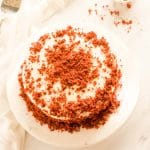
Eggless Red Velvet Cake
This gorgeous eggless red velvet cake is rich and moist! It's filled and topped with a luscious cream cheese frosting that's to die for!
Servings 10 -12, approximately
Equipment
- two 8-inch cake pans
- parchment paper
Ingredients
For the cake
- 3 cups (375g) all purpose flour
- 2 tablespoons (14g) unsweetened cocoa powder
- 2 teaspoons baking soda
- 1 teaspoon baking powder
- ¼ teaspoon salt
- 1 ½ cups (300g ) sugar
- 1 ¼ cup (310ml) buttermilk (or make your own by adding 1 tablespoon + ¾ teaspoon vinegar to 1¼ cup milk)
- ½ cup (125ml) light vegetable oil
- 2 teaspoons vanilla
- 1 ½ teaspoons red gel food coloring (I use Wilton Red Red)
- 1 tablespoon white vinegar
For the cream cheese frosting
- 8 oz (226g) cream cheese, full-fat
- ½ cup (113 g / 4 oz) unsalted butter, at room temperature
- 4-5 cups (500g-650g) powdered sugar
- 1 teaspoon vanilla
Instructions
- Preheat the oven to 350F / 180C.
- Grease, flour and then line the bottoms of the cake pans with parchment paper. Set them aside.
Make the cakes
- Whisk together the flour, cocoa powder, baking soda, baking powder and salt in a mixing bowl.
- Pour in the buttermilk, vanilla, oil, vinegar and food coloring to the dry ingredients. Use the hand mixer to mix everything until just combined.
- Pour the cake batter into the prepared pans. (To get equal layers, I like to weigh the batter first and then evenly distribute it.)
- Bake the cakes for about 35 minutes or until a toothpick inserted in the middle comes out clean.
- Let the cakes rest in the pans for about 10 minutes. Then run a knife around the edges, turn the pans upside down and remove the cakes. Transfer them to a cooling rack to cool completely before frosting.
- Trim the tops. Use a box grater to make crumbs with them. Set aside.
Make the cream cheese frosting
- In a large mixing bowl, beat the butter on high speed for about 5 minutes, until it's creamy and fluffy.
- Then gradually add the powdered sugar. (I usually add it in 2 or 3 batches.)
- Add the vanilla and cream cheese and mix until everything is well combined.
- If your frosting is too thin, add a bit more powdered sugar and place it in the refrigerator to thicken. If it's too thick, you can add a little milk, a teaspoon at a time, to thin it out a bit.
Assemble the cake
- Place one cake layer on a serving plate or cake stand and spread about 1 cup frosting on top. (I use an offset spatula to even it out.)
- Then add the second cake layer on top with the bottom side facing up. Spread frosting on the top and sides. Use a bench scraper or an offset spatula to smooth out the sides.
- Decorate the cake with the reserved cake crumbs.
- Enjoy!
Notes
Every oven is different, so baking times may vary. Check the cakes after about 30 minutes.
Storage Tips
You can cover this cake well or keep it in an air tight container and then store it in the refrigerator for up to about 5 days.
Freezing Instructions
This cake freezes well frosted or unfrosted. I like to wrap individual slices in plastic wrap and then place them in freezer bags. They can be frozen for up to about 3 months. To thaw, let them sit in the refrigerator overnight before serving.
Picture Tutorial & Tips
I have a detailed picture tutorial in my post to help you out with each step of the recipe as well as lots of tips to ensure success.
Baking Measurements
I have used weight measurements for all the recipes on this website. Even though I have also included American volume measurements for convenience, I highly recommend using a digital kitchen scale to weigh all ingredients for the most accurate measurements. Digital kitchen scales are more precise than cups, which is so important in baking, and they give the most accurate, consistent results. Happy baking!
©Pastry Wishes